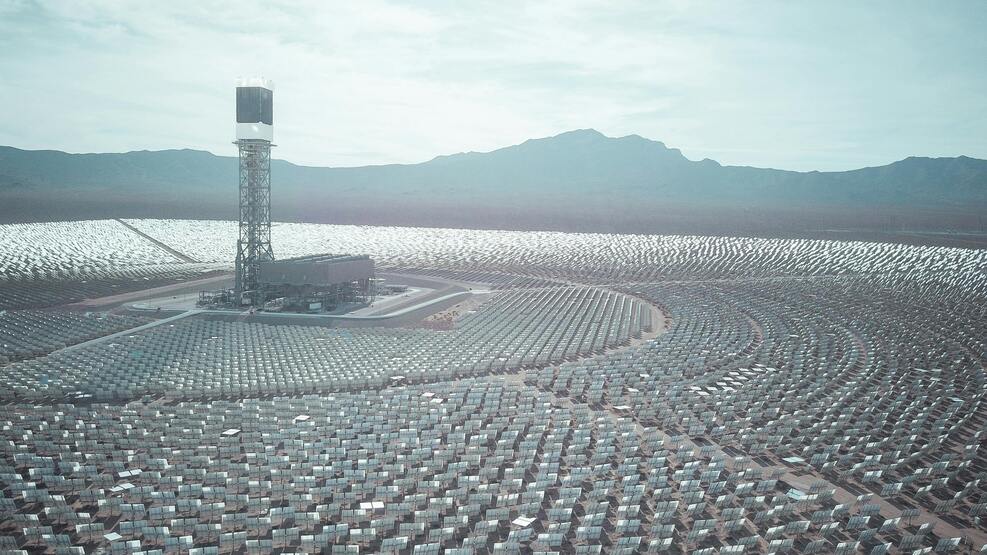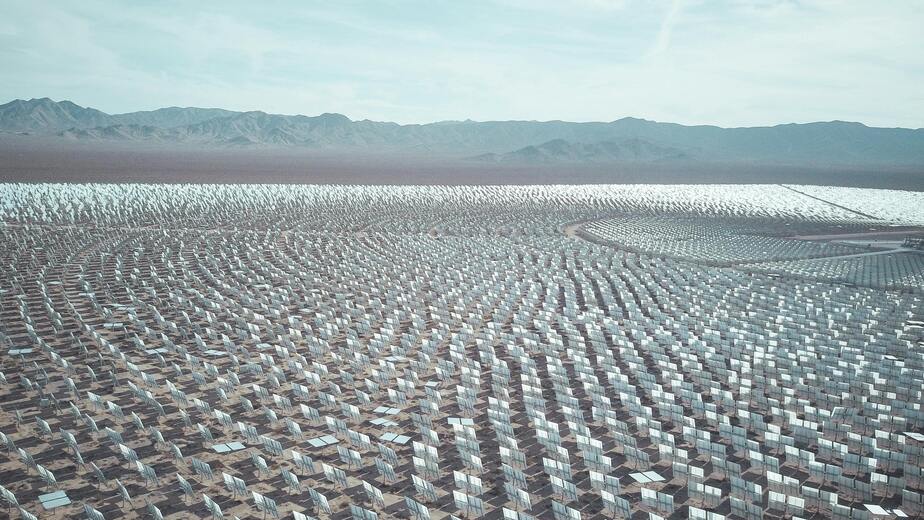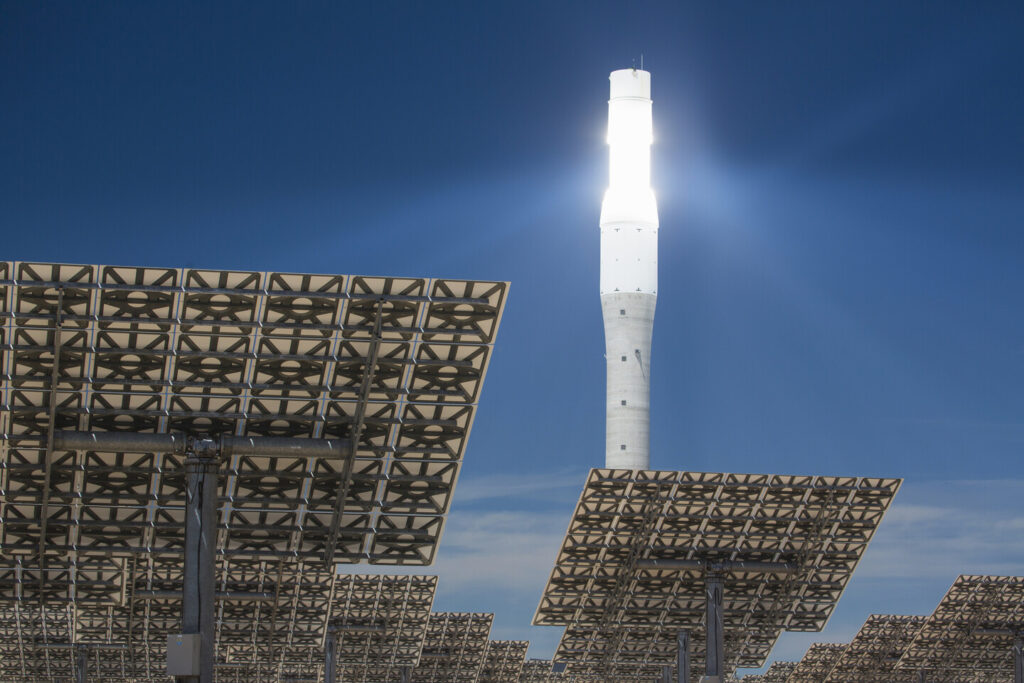Solar thermal plants and solar thermal technology
What is Solar Thermal Technology?
Thermosolar technology is an advanced renewable energy generation solution that harnesses the heat from the sun to produce electricity or useful heat. Through specialized systems that concentrate solar radiation, such as mirrors or lenses, this energy is used to heat fluids that generate steam, which powers turbines connected to electrical generators.
This technology plays a crucial role in the energy transition towards a more sustainable future, especially in regions with high solar irradiation, such as Spain and other areas of the global solar belt. Unlike photovoltaic technologies, which directly convert sunlight into electricity, thermosolar relies on thermal processes that offer significant advantages, such as integration with thermal energy storage systems.

Definition and Basic Principles of Solar Thermal Energy
Solar thermal energy is based on the principle of concentrating solar radiation to reach high enough temperatures to generate electricity or industrial heat. This process is carried out through optical systems, such as parabolic mirrors or heliostats, which concentrate sunlight onto a point or focal line.
The heat transfer fluid, such as thermal oil, molten salts, or even water, carries this heat to a steam generator, which powers a Rankine cycle turbine. Additionally, its storage capacity allows electricity generation even when the sun is not shining, making it a flexible and scalable option to meet energy demand at all times.
Diferencias entre Energía Termosolar y Fotovoltaica
Differences Between Solar Thermal and Photovoltaic Energy
Although both technologies use the sun as an energy source, their methods and applications differ.
- Solar Thermal Energy: Uses solar heat to generate electricity or useful heat, with the possibility of large-scale thermal storage using molten salt tanks or thermocline systems.
- Photovoltaic Energy: Directly converts sunlight into electricity through solar cells, without the need for an intermediate thermal process.
Solar thermal technology offers advantages such as greater storage capacity and the ability to provide electricity beyond daylight hours, making it an ideal solution for grids with high penetration of renewable energies.
Types of Solar Thermal Technology
Concentrated solar energy uses various technological configurations depending on how they concentrate and transform solar energy. Each type is designed to maximize performance in different scenarios and application scales.

– Cylindrical Parabolic Concentrator Systems (CPC)
These systems use parabolic mirrors to concentrate solar radiation onto a receiver tube located at the focal line. A fluid, such as thermal oil, circulates through this tube and transfers the heat to the steam generation system. CPC systems are the most mature and widely used solar thermal technology, especially in large projects such as those developed in Spain and Morocco.
– Central Tower Systems
This technology is also known as central tower solar plants, central receiver systems, or solar power towers, among other names. In this configuration, hundreds or thousands of mirrors called heliostats concentrate sunlight onto a receiver located at the top of a tower. This receiver heats a fluid, typically molten salts, which is stored and used to generate electricity when needed.
Central tower systems are known for their high efficiency and ability to integrate with large-scale thermal storage systems, making them an ideal solution for large-scale energy storage.
– Parabolic Dish Systems
This technology uses a parabolic reflector to concentrate solar radiation onto a single focal point where a receiver is located. It is more suitable for small-scale applications, such as decentralized installations or systems in rural areas.
– Linear Fresnel Systems
Fresnel systems use flat mirrors arranged in rows to concentrate sunlight onto a fixed receiver. Although they are less efficient than cylindrical parabolic systems, they offer advantages in terms of cost and design simplicity, making them attractive for certain industrial applications.
Advantages of Solar Thermal Energy
Solar thermal energy offers numerous benefits that position it as one of the key technologies for achieving a sustainable and reliable energy system.

– High Energy Efficiency
The concentration of solar energy allows for very high temperatures, which results in greater performance in generating electricity or useful heat.
– Integrated Thermal Storage
One of the main advantages of solar thermal energy is its ability to store heat through molten salts or other mediums, ensuring a continuous energy supply even during the night or on cloudy days.
– Reduction in Carbon Emissions
By using the sun as the primary source and eliminating dependence on fossil fuels, solar thermal technology significantly contributes to the decarbonization of the global energy system.
– Scalability for Large Projects
Solar thermal plants are ideal for large-scale applications, such as electricity generation plants or large thermal industries, due to their ability to meet energy demands efficiently and sustainably.
Technological Innovations in the Solar Thermal Sector and Solar Thermal Plants
Constant advancements in solar thermal technology are driving its efficiency, reducing costs, and expanding its applications. These innovations are crucial in solidifying solar thermal energy as a key solution in the renewable energy landscape.
– Advanced Thermal Storage
One of the most promising areas of innovation in the solar thermal sector is the development of new thermal storage systems. Emerging technologies include:
Next-generation molten salt systems: Offering higher thermal capacity and stability at high temperatures.
Phase Change Materials (PCM): Allowing more compact and efficient energy storage.
Thermocline systems: Based on the use of stratified storage media, offering a balance between cost and capacity.
These improvements not only increase the economic viability of solar thermal energy but also make it more competitive compared to other storage technologies, such as lithium-ion batteries.
– New Generation Plant Design
The design of solar thermal plants is evolving to maximize energy capture and operational efficiency. Notable examples include:
High-concentration solar towers: Which increase the temperature of the thermal fluid, improving heat-to-electricity conversion in the power cycle.
Hybrid design: Combining solar thermal technology with photovoltaics or green hydrogen generation to ensure a more flexible and diversified energy supply.
– Automation and Digitalization
The use of digital technologies is transforming the operation and maintenance of solar thermal plants. Notable tools include:
Predictive modeling: To anticipate operational issues and optimize efficiency.
AI-based control systems: Dynamically adjusting operations based on energy demand and weather conditions.
Real-time monitoring: Enhancing responsiveness and reducing operational costs.
Environmental Benefits in Solar Thermal Plants
Concentrated solar technology plays a crucial role in mitigating climate change and transitioning towards a more sustainable energy model. Its environmental benefits range from emission reduction to the preservation of natural resources.

– Reduction of CO₂ Emissions
By generating electricity without fossil fuels, solar thermal energy significantly contributes to the reduction of carbon dioxide emissions. Compared to traditional thermal power plants, solar thermal plants:
Completely eliminate direct greenhouse gas emissions.
Reduce the carbon footprint of the electricity sector, promoting a path towards net-zero emissions.
– Sustainable Resource Use
Unlike other energy sources, solar thermal uses abundant and renewable resources like sunlight, reducing reliance on finite fuels such as natural gas or coal. Additionally:
Thermal storage systems, such as molten salts, are more sustainable than chemical batteries in terms of material extraction and recycling.
Solar thermal does not require large amounts of water for its operation, unlike other power generation technologies.
– Positive Impact on Biodiversity
The installation of solar thermal plants has a lesser environmental impact compared to other energy infrastructures. Thoughtful design measures ensure that:
Plants are integrated into areas of low ecological impact.
Disruptions to nearby natural habitats are minimized.
Main Countries and Regions in Solar Thermal Energy
Leadership in the implementation of solar thermal technology is driven by a combination of government policies, natural resources, and the willingness to invest in a clean energy system.
– Spain as a Global Leader
Spain stands as a global leader in solar thermal energy, thanks to its experience in developing innovative plants and its commitment to renewable energy. With over 50 solar thermal plants in operation, the country stands out for:
Its installed capacity, which exceeds 2.3 GW, making it one of the largest in the world.
Iconic projects like Gemasolar and Andasol, which serve as benchmarks for the rest of the world.
– Growth in the Middle East and North Africa (MENA)
The MENA region is investing in large solar thermal projects due to its abundant solar radiation. Notable examples include:
Noor Ouarzazate Complex in Morocco: One of the largest solar thermal installations in the world, designed to significantly reduce the country’s dependence on fossil fuels. It combines parabolic trough and central tower technology.
Noor Midelt, Morocco: This hybrid project aims to optimize renewable generation by combining CSP and PV technologies with thermal storage.
Shams 1, UAE: Inaugurated in 2013, it is one of the first large-scale plants in the Arabian Gulf. It is a parabolic trough plant. Its design includes an automated cleaning system to maintain efficiency in desert conditions.
– Expansion in Latin America and Asia
Countries like Chile and China are emerging as key players in the solar thermal sector.
Chile: With projects in the Atacama Desert, it is leveraging its exceptional solar radiation to lead in Latin America.
China: The country is constructing multiple solar thermal plants as part of its strategy to reduce its reliance on coal and promote renewable energy.
Challenges and Costs of Solar Thermal Technology in Solar Thermal Plants
Despite the numerous benefits offered by solar thermal technology, there are technical, economic, and logistical challenges that limit its large-scale implementation. Identifying and overcoming these obstacles is essential to maximizing its potential in the energy market.
– Competitive Cost Compared to Other Technologies
While solar thermal energy benefits from cost reductions due to economies of scale, it still faces challenges related to:
High Initial Costs: Developing solar thermal infrastructure, such as collectors and storage systems, requires significant investment.
Competition with Photovoltaic Energy: The declining prices of photovoltaic solar panels make it difficult for solar thermal technology to compete on equal footing.
Financing and Subsidies: In many markets, solar thermal energy relies on government incentives to remain economically viable.
Applications of Solar Thermal Plants and Benefits in Today's Market
Solar thermal technology is finding applications across various sectors thanks to its flexibility and ability to integrate energy storage solutions.

– Grid Stability and Energy Storage
One of the primary benefits of solar thermal technology is its ability to ensure grid stability. Using thermal storage systems, such as molten salt tanks, solar thermal plants can store energy as heat during periods of peak generation and release it when demand rises. This provides:
Operational flexibility: Ensures continuous generation, even without direct solar irradiation.
Intermittency mitigation: Complements intermittent renewable sources like solar photovoltaics and wind.
Demand peak reduction: Helps prevent grid overloads during periods of high electricity demand.
– Reduction of Carbon Emissions
Solar thermal energy significantly contributes to the decarbonization of the energy sector. By replacing fossil fuels in electricity generation, reduce greenhouse gas emissions, supporting global net-zero goals. Hybrid projects (CSP + PV) further optimize clean and stable energy production.
– Applications in Industrial Processes
Solar thermal energy is also being used to decarbonize industrial processes by providing:
Process heat: Required in industries such as chemicals, food processing, and textiles.
Thermal energy supply: Ideal for applications like distillation, drying, and pasteurization.
Projects and Technology in RPow Solar Thermal Plants
RPow is at the forefront of developing and implementing solar thermal projects, leveraging its expertise in design, thermal storage, and the integration of renewable technologies.
Innovations in Solar Thermal Plants
RPow has been involved in projects distinguished by their technological innovation, such as:
Hybrid Systems (CSP + PV): Combining solar thermal (CSP) with photovoltaic (PV) systems and energy storage to enhance flexibility and ensure continuous electricity supply.
Advanced Molten Salt Storage: Improving the capacity and efficiency of thermal storage systems, enabling greater operational flexibility and long-term reliability.
Solar Thermal Plant Modeling and Simulation: RPow develops advanced models to simulate and optimize the design, operation, and performance of solar thermal plants under various climatic and operational conditions. These simulations help:
Optimize the initial plant design.
Predict the efficiency of storage and energy generation systems.
Reduce risks and costs associated with the implementation of new technologies.
Proyectos Destacados en Energía Termosolar
RPow ha participado en proyectos emblemáticos que reflejan su compromiso con la sostenibilidad y la excelencia técnica, entre ellos:
